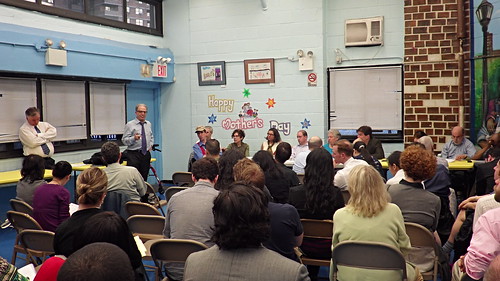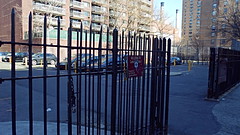At a contentious meeting last night, tenants of the New York Public Housing Authority and their neighbors expressed their opposition to the agency’s plan to allow development on parking lots and playgrounds. Meanwhile the authority announced a delay in its search for potential developers.
David McWater, chair of Community Board 3’s Land Use committee, struggled to keep the meeting in check as Damaris Reyes, executive director of Good Old Lower East Side and a resident of Baruch Houses, voiced tenants’ concerns about loss of light and open space, as well as the structural safety of existing buildings and power and sewage systems.
The bigger fear Ms. Reyes articulated was that the infill plan was the first step toward the eventual privatization of New York City’s public institutions. “I refuse to believe that in a city like New York, with such brilliant minds, that we cannot come up with a plan that will generate revenue, that will enhance the lives of public housing residents, and prevents future speculation, because need I remind everyone that this is waterfront property,” she said, worrying that if given an inch, the housing authority would take a mile. “There is no agreement that says you will not sell off any more land,” she said. “There’s no agreement that says you will not demolish another playground.”
Ms. Reyes again asked the housing authority to renegotiate the $75 million it pays the City for “special police services,” a concern that has also been raised by State Senator Daniel Squadron and others.
Kathy von Hartz, speaking for Friends of Meltzer, a neighborhood group advocating for Meltzer Houses, emphasized the importance of recreational space for the seniors’ development. “At Meltzer the plan would destroy this park,” she said. “Why cut down 31 trees in their prime?”
City Council member Rosie Mendez, who was in attendance, and other members of the Committee on Public Housing have demanded the housing authority slow down its process and voluntarily opt in to the city’s Uniform Land Use Review Procedure, a standardized process for public engagement regarding changes in land use. But Fred Harris, the housing authority’s Executive Vice President of Development, again indicated that was unlikely, and said the process of environmental and engineering reviews required by the federal government was quite enough.
There have been ongoing frustrations with the agency’s poor handling of releasing information and accepting resident feedback. Last week, Smith Houses residents walked out of a “roundtable” meeting with the agency, leaving three tenants and a couple dozen N.Y.C.H.A. staffers behind. Aixa Torres, the tenants association president who led the walkout, explained that “part of Section 18 requires participation. Where’s the participation when it’s their agenda and we’re the ones affected? They were disrespectful.”
Smith Houses has been working with the Urban Justice League to take legal action if and when the housing authority does seek Section 18 approval from the U.S. Department of Housing and Urban Development to lease the land targeted for development. Ms. Torres said 325 Smith families are already on board to join the legal battle.
Last night, there was one notable supporter of the housing authority’s plan. Bernard Marti, a member of the Land Use committee and a longtime resident of Jacob Riis houses, described himself as “a product of public housing” whose father had worked as a janitor in N.Y.C.H.A. developments for 25 years. “I have seen public housing go down the drain,” he said. But his calls for more tenant diversity were interrupted by shouts of “We’re going to lose our apartments!”
In the end, the committee resolved to again compose a statement asking the agency to slow its process, delay the release of a Request For Proposal, and to engage the full community. Though the Community Board’s role is only advisory in nature, Mr. Harris indicated that the R.F.P., which was set to be released at the end of this month, now may not happen until the end of May.





